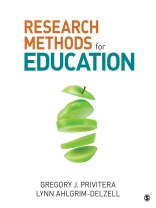From award-winning author Gregory J. Privitera and Lynn Ahlgrim-Delzell,
Research Methods for Education covers the different quantitative and qualitative research methods specific to their use in educational research. This new text uses a problem-focused approach that fully integrates the decision tree—from choosing a research design to selecting an appropriate statistic for analysis.
With a conversational, student-friendly writing style, and examples from a wide variety of education-related fields, the authors show how methods and statistics work together and enable the testing of hypotheses through use of the scientific method. Students will become informed consumers of research with the ability to understand a research article, judge its quality and apply the methods in action research to inform educational practice.
Give your students the SAGE edge!
SAGE edge offers a robust online environment featuring an impressive array of free tools and resources for review, study, and further exploration, keeping both instructors and students on the cutting edge of teaching and learning.
Tabella dei contenuti
About the Authors
Acknowledgments
Preface
SECTION I: SCIENTIFIC INQUIRY
Chapter 1—Introduction to Scientific Thinking
1.1 Science as a Method of Knowing
1.2 The Scientific Method: Relevance in Educational Research
1.3 Other Methods of Knowing
1.4 The Goals of Science
1.5 Approaches in Acquiring Knowledge
1.6 Distinguishing Science From Pseudoscience
Chapter 2—Generating Testable Ideas
2.1 Generating Interesting and Novel Ideas
2.2 Converting Ideas to Hypotheses and Theories
2.3 Developing Your Idea: Deduction and Induction
2.4 Performing a Literature Review
2.5 Ethics in Focus: Giving Proper Credit
2.6 The “3 Cs” of an Effective Literature Review
2.7 Testing Your Idea: Confirmation and Disconfirmation
2.8 Ethics in Focus: Publication Bias
Chapter 3—Research Ethics
3.1 Ethics in Educational Research
3.2 The Need for Ethics Committees in Research: A Historical Synopsis
3.3 Ethics in Focus: Classic Examples From Psychology
3.4 Human Participant Research: IRBs and the AERA Code of Conduct
3.5 Ethics in Focus: Anonymity and Confidentiality
3.6 Additional Ethical Considerations: Scientific Integrity
SECTION II: DEFINING AND MEASURING VARIABLES, SELECTING SAMPLES, AND CHOOSING AN APPROPRIATE RESEARCH DESIGN
Chapter 4—Scientific Variables, Validity, and Reliability
4.1 Criteria for Defining and Measuring Variables
4.2 Constructs and Operational Definitions
4.3 Types of Variables
4.4 Scales of Measurement
4.5 Reliability of a Measurement
4.6 Validity of a Measurement
4.7 Intervention Fidelity
4.8 Selecting a Measurement Procedure
4.9 Ethics in Focus: Replication as a Gauge for Fraud?
Chapter 5—Instrumentation
5.1 Classifying Data Collection Instruments
5.2 Tests and Measures
5.3 Types of Questionnaire Items
5.4 Rules for Writing Survey Items
5.5 Administering Questionnaires
5.6 Interviewing
5.7 Ethics in Focus: Maintaining Confidentiality of Collected Data
Chapter 6—Sampling From Populations
6.1 Why Do Researchers Select Samples?
6.2 Subjects, Participants, and Sampling Methods
6.3 Methods of Sampling: Nonprobability Sampling
6.4 Methods of Sampling: Probability Sampling
6.5 Sampling Error and Standard Error of the Mean
6.6 Potential Biases in Sampling
6.7 Ethics in Focus: Research in Schools
Chapter 7—Choosing a Research Design
7.1 Designing a Study to Answer a Question
7.2 Categories of Research Design
7.3 Internal and External Validity
7.4 Demonstrating Cause in an Experiment
7.5 Ethics in Focus: Beneficence and Random Assignment
7.6 Threats to the Internal Validity of a Research Study
7.7 Threats to the External Validity of a Research Study
7.8 External Validity, Experimentation, and Realism
7.9 A Final Thought on Validity and Choosing a Research Design
SECTION III: NONEXPERIMENTAL RESEARCH DESIGNS
Chapter 8—Naturalistic and Existing Data Research Designs
Naturalistic Designs
8.1 An Overview of Naturalistic Design
8.2 The Research Setting: Natural and Contrived Settings
8.3 Techniques for Making Unobtrusive Observations
8.4 Making Observations
8.5 Ethics in Focus: Influencing Participant Behavior
Existing Data Designs
8.6 An Overview of Existing Data Designs
8.7 Archival Research, Content Analysis, and Meta-Analysis
8.8 Ethics in Focus: Existing Data and Experimenter Bias
Chapter 9—Survey and Correlational Research Designs
Survey Designs
9.1 An Overview of Survey Designs
9.2 Surveys, Sampling, and Nonresponse Bias
9.3 Survey Methods
9.4 Ethics in Focus: Handling and Administering Surveys
Correlational Designs
9.5 The Structure of Correlational Designs
9.6 Describing the Relationship Between Variables
9.7 Limitations in Interpretation
9.8 Correlation, Regression, and Prediction
Chapter 10—Introduction to Qualitative Research
10.1 What Is Qualitative Research?
10.2 Foundations of Qualitative Research
10.3 Theoretical Perspectives in Qualitative Research
10.4 Steps in Qualitative Research
10.5 Role of the Researcher and Entry Into the Field
10.6 Sampling in Qualitative Research
10.7 Types of Qualitative Data
10.8 Ethics in Focus: Using the Internet in Qualitative Research
Chapter 11—Phenomenology, Ethnography, and Ground Theory Designs
11.1 An Overview of Phenomenology Designs
11.2 An Example of Phenomenology Research
11.3 Considerations for Participant Self-Descriptions
11.4 An Overview of Ethnography Designs
11.5 Making Observations in Group Settings
11.6 An Example of Ethnography Research
11.7 An Overview of Netnography and Autoethnography Research
11.8 An Overview of Grounded Theory Designs
11.9 An Example of Grounded Theory Designs
11.10 Ethics in Focus: Anonymity in Qualitative Research
Chapter 12—Narrative Inquiry, Case Study, and Critical Theory Designs
Narrative Research Designs
12.1 An Overview of Narrative Research
12.2 Considerations for Narrative Inquiry
12.3 An Example of Narrative Research
Case Study Designs
12.4 An Overview of Case Study Designs
12.5 Types of Case Study Designs
12.6 Combining Case Study Design With Quantitative Data
Critical Theory Designs
12.7 An Overview of Critical Theory Designs
12.8 Types of Critical Theory Designs
12.9 Ethics in Focus: Retelling Human
SECTION IV: QUASI-EXPERIMENTAL, EXPERIMENTAL, AND MIXED-METHODS RESEARCH DESIGNS
Chapter 13—Quasi-Experimental and Single-Case Experimental Designs
Quasi-Experimental Designs
13.1 An Overview of Quasi-Experimental Designs
13.2 One-Group Designs
13.3 Quasi-Experimental Design: Nonequivalent Control Group Designs
13.4 Quasi-Experimental Design: Time-Series Designs
Single-Case Experimental Designs
13.5 An Overview of Single-Case Designs
13.6 Single-Case Baseline-Phase Designs
13.7 Application of Single-Case Designs in an Applied School Setting
13.8 Single-Case Designs in the Identification of Effective
13.9 Validity, Stability, Magnitude, and Generality
13.10 Ethics in Focus: The Ethics of Innovation
Chapter 14—Experimental Designs: Between Subjects, Within Subjects, and Factorial
14.1 Conducting Experiments: Between-Subjects Design
14.2 Experimental Versus Control Group
14.3 Manipulation, Variability, and the Independent Variable
14.4 Ethics in Focus: The Accountability of Manipulation
14.5 Comparing Two or More Independent Samples
14.6 Conducting Experiments: Within-Subjects Design
14.7 Controlling Time-Related Factors
14.8 Comparing Two or More Related Samples
14.9 Comparing Between-Subjects and Within-Subjects Designs
14.10 Conducting Experiments: Factorial Experimental Designs
14.11 Types of Factorial Designs
14.12 Including Quasi-Independent Factors in an Experiment
14.13 Higher-Order Factorial Designs
Chapter 15—Mixed-Methods Research Designs
15.1 An Overview of Mixed-Methods Research Designs
15.2 When Use of Mixed-Methods Research Designs Is Appropriate
15.3 Advantages and Disadvantages of Using a Mixed-Methods Research Design
15.4 Types of Mixed-Methods Research Designs
15.5 Conducting Mixed-Methods Research
15.6 Ethics in Focus: Minimizing Risk Associated With Qualitative and Quantitative Research
SECTION V: APPLIED RESEARCH DESIGNS
Chapter 16—Action Research
16.1 The Fundamentals of Action Research
16.2 Types of Action Research
16.3 The Process of Conducting Action Research
16.4 Ethics in Focus: Ethical Considerations in Action Research
16.5 Evaluation of Action Research
Chapter 17—Program Evaluation
17.1 The Fundamentals of Program Evaluation
17.2 Difference Between Program Evaluation and Research
17.3 Program Evaluation Standards
17.4 Utility and Importance of Program Evaluation
17.5 Ethics in Focus: Considerations for Protecting the Welfare of Stakeholders
17.6 Models for Program Evaluation
17.7 Steps in Program Evaluation
SECTION VI: ANALYZING, INTERPRETING, AND COMMUNICATING RESEARCH DATA
Chapter 18—Analysis and Interpretation: Exposition of Data
18.1 Descriptive Statistics: Why Summarize Data?
18.2 Frequency Distributions: Tables and Gra
18.3 Measures of Central Tendency
18.4 Measures of Variability
18.5 Graphing Means and Correlations
18.6 Using Correlation to Describe Reliability
18.7 Standard Scores, z Scores, Percentile Ranks, and Age/Grade Equivalents
18.8 Ethics in Focus: Deception Due to the Distortion of Data
Chapter 19—Analysis and Interpretation: Making Inferences About Data
19.1 Inferential Statistics: What Are We Making Inferences About?
19.2 Types of Error and Power
19.3 Parametric Tests: Applying the Decision Tree
19.4 Main Effects and Interactions
19.5 Identifying Main Effects and Interactions in a Graph
19.6 Correlation and Regression
19.7 Nonparametric Tests: Applying the Decision Tree
19.8 Effect Size: How Big Is an Effect in the Population?
19.9 Estimation: What Are the Possible Values of a Parameter?
19.10 Confidence Intervals, Significance, and Effect Size
19.11 Issues for Interpretation: Precision and Certainty
19.12 Ethics in Focus: Full Disclosure of Data
Chapter 20—Analysis and Interpretation: Making Inferences About Qualitative Data
20.1 Qualitative Versus Quantitative Data Analysis
20.2 Decisions About How to Record Narrative Data
20.3 Decisions About Quantitative Data Analysis and Interpretation
20.4 General Process of Qualitative Data Analysis
20.5 Qualitative Coding Tools
20.6 Interpretations Made Using Different Qualitative Designs in the Data Analysis Process
20.7 Criteria of Trustworthiness
20.8 Ethics in Focus: Confidentiality
Chapter 21—Communicating Research: Preparing Manuscripts, Posters, and Talks
21.1 Elements of Communication
21.2 Writing a Manuscript: Writing Style and Language
21.3 Elements of an APA-Style Manuscript
21.4 Literature Reviews
21.5 Reporting Observations in Qualitative Research
21.6 Ethics in Focus: Credit and Authorship
21.7 Presenting a Poster
21.8 Giving a Professional Talk
Appendix A: APA-Style Writing, Sample Manuscript, and Posters
A.1 Essentials for Writing APA-Style Research Papers
A.2 Grammar, Punctuation, and Spelling (GPS) Writing Guide
A.3 Sample APA-Style Manuscript
A.4 Poster Template and Sample Poster
Appendix B: Instructions for Randomizing and Counterbalancing
B.1 Random Numbers Table
B.2 Constructing a Latin Square
Glossary
References
Index
Circa l’autore
Gregory J. Privitera is a professor of psychology at St. Bonaventure University where he is a recipient of its highest teaching honor, The Award for Professional Excellence in Teaching, and its highest honor for scholarship, The Award for Professional Excellence in Research and Publication. Dr. Privitera received his Ph D in behavioral neuroscience in the field of psychology at the State University of New York at Buffalo and continued with his postdoctoral research at Arizona State University. He is a nationally award-winning author and research scholar. His textbooks span across diverse topics in psychology and the behavioral sciences, including an introductory psychology text, four statistics texts, two research methods texts, and multiple other texts bridging knowledge creation across health, health care, and analytics. In addition, Dr. Privitera has authored more than three dozen peer-reviewed papers aimed at advancing our understanding of health and informing policy in health care. His research has earned recognition by the American Psychological Association, and in media to include Oprah’s Magazine, Time Magazine, and the Wall Street Journal. He mentors a variety of undergraduate research projects at St. Bonaventure University, where dozens of students, many of whom have gone on to earn graduate and doctoral degrees at various institutions, have coauthored and presented research work. In addition to his teaching, research, and advisement, Dr. Privitera is a veteran of the U.S. Marine Corps, is an identical twin, and is married with two daughters, Grace Ann and Charlotte Jane, and two sons, Aiden Andrew and Luca James.












